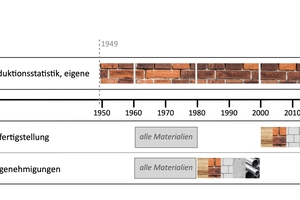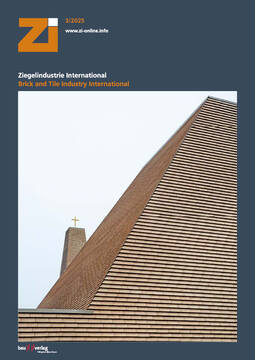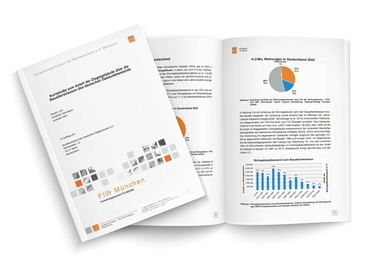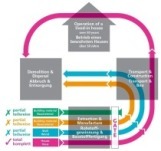Long-lasting construction methods in lifecycle assessment
Building statistics evaluation: How is Germany built?
1. Introduction and motivation
In the building sector, lifecycle assessment in association with greenhouse gas emissions (GHG) plays an integral role, both in regard to refurbishment and new construction planning. However, it is not that long ago that not everyone involved in construction was so aware of these issues. We owe this upswing to, amongst other things, developments in European and national climate policy, which, in order to accelerate implementation, has geared national funding policy since 2021 to mitigating climate impact and reducing GHG emissions.
The methods for lifecycle assessment (LCA) are described in the standards DIN EN ISO 14040 [1] and 14044 [2]. The ecological assessment of construction products is performed in accordance with the additional general conditions specified in DIN EN 15804 [3]. Building lifecycle assessments have to be calculated in compliance with the standard DIN EN 15978 [4] and for the whole building lifecycle. Within the framework of sustainability certification and funding policy calculation rules according to Qualitätssiegel Nachhaltiges Gebäude (QNG – Sustainable Building Certification), the assessment horizon for building lifecycle assessments has been set at 50 years in Germany. From the ratio of the building service life and technical service life of a (construction) product, the replacement rate in the building lifecycle is calculated, which, for the purpose of lifecycle assessment, is listed in the BBSR service life table [5]. For building-related GHG emissions, a 50-year assessment period is much too short if one considers that buildings – and here especially residential buildings – are built for much longer periods and for more than one generation. It is therefore not surprising that construction methods that incur high greenhouse gas emissions primarily in the production of materials for load-bearing structures but also boast a long technical service lifetime cannot play on the advantage of their long life in ecological terms. The defined calculation method “cuts” off after 50 years and assumes a subsequent demolition of a building. As a result, the resources used, which are bound up in the building or in its construction, are not evenly spread over the number of actual service years, but in accordance with the regulations only over the building service life of 50 years. One could refer here to a “residual ecological value“.
Policy approach favours efficient and sustainable utilization of available resources and the recyclability of buildings or the building products used in their construction. In the technical terminology, this principle is referred to as “cradle-to-cradle”. The current calculation methods for the LCA of buildings imply, however, much more a “cradle-to-grave” model. Accordingly, an incentive effect to short-lived, deconstructible construction methods has evolved.
The complete article can be read in the journal “nbau” volume 3, issue 6 (2024) [6].
2. Objective of the “Brief study on the share of brick buildings over the building age categories of building stock in Germany”
The problem described in the introduction concerns primarily solid, mineral-based construction methods such as brick constructions, which has evidently proven effective over centuries. To create a scientific foundation for proper consideration of long-life construction methods, in summer 2023, the Federal Association of the German Brick and Tile Industry commissioned a study, which was conducted by the Forschungsinstitut für Wärmeschutz e.V. (FIW – Thermal Insulation Research Institute) [7]. Objective of this study was to determine the share of brick construction in the building stock in Germany for as long a period as possible. In addition, this share was to be presented according to building age, similar to the already existing categories for energy building quality [8].
3. Evaluation of existing statistical data
For scientific derivation of the share of brick building in Germany, first a reliable database had to be created. For this, the FIW assessed long series of data from Germany’s Federal Statistical Office (Destatis) for building permits and completions as well as other studies already conducted on this topic.
3.1. Residence building stock in Germany
According to information from Germany’s Federal Statistical Office [9], in 2022, there were around 19.5 mill. residential buildings in Germany, containing around 41.9 mill. residential units.
»Fig. 1 shows the distribution of the residential buildings by building age categories or building age. This distribution was compiled in the scope of the dena-flagship study on “Integrated Energy Transition“ [10] and derived from a building und plant model developed by the FIW München and the Institute for Building Systems Engineering Research and Application (ITG) in Dresden. The building model is described in detail in the study “Climate neutrality 2045 - transformation of the building sector“ [11].
From the year 1994, in addition, the number of completed residential buildings in accordance with the specific building completion figures released by Germany’s Federal Office of Statistics were taken into account and integrated in the distribution.
The datasets of the Federal Statistics Office for annual building completions and the figures for annual building applications by the primarily used building material reach in the first case only go back to the year 2000, in the second case back to 1980. So no periods of more than 50 years can be represented. To record datasets that lie further back in the past, the production data recorded by the Federal Association of the German Brick and Tile Industry were referenced (see Section 3.2). These go back to the year 1949 and were reconciled with the data of the Federal Statistics Office for the periods 1980 and 2000 to 2022.
3.2. Production statistics for the clay brick and tile industry
As an industry and employers’ association, the Federal Association of the German Brick and Tile Industry has focussed and represented many issues concerning the clay brick and tile industry. The Association collates figures on the production of clay brick products, the number of companies and their employees, and publishes this data in the form of an annual report. The archived annual reports go back to 1949 (see »Fig. 2) and provided important input for the study conducted on the quantities of masonry bricks actually produced.
4. Method for recording the share of brick building in the residential building stock by building age categories
For the determination of the share of brick buildings in German building stock, data from diverse sources must be ordered, checked for their time overlap and put into chronological order (see »Fig. 3).
From the overlaps of the various datasets, there result three time ranges, which were evaluated and analysed for scientific derivation of the number of brick buildings in their sequence as follows.
Time range 1 (1980 to 2022): Overlap and very good agreement of Destatis data (building completions & building permits according to the primarily used construction material) and brick production data -> direct determination of the brick share
Time range 2 (1961 to 1979): Overlap of the datasets from Destatis (building completions & building permits without details on the construction material used ) and brick production data -> indirect / adjusted determination of the brick percentage
Time range 3 (1949 to 1960): No Destatis data available, only brick production data à extrapolation (scientific approach) on the basis of the agreements for Ranges 1 and 2
For the transfer of the secured results from Range 1 to periods lying further back, an annual ratio from mainly completed brick buildings (according to Destatis) and brick production levels (BV Ziegel) is formulated (see »Fig. 4). On the basis of the ratios shown here, information can be obtained on the development of the brick products up to the high-thermal-insulation vertically perforated clay blocks commonly used today. The introduction of the 2nd Thermal Insulation Ordinance in 1984 and the Energy Saving Ordinance in 2002 in Germany resulted in much higher requirements for heat protection. As a result of this, masonry brick products were optimized and their thermal conductivity improved, a development that was also accompanied with a greater thickness of the masonry, that is with a greater brick volume for built square metre of exterior wall. This can be clearly seen in the years after 1984 and 2002 based on the lower ratios in »Fig. 4.
From the calculated ratios according to »Fig. 4, for the period from 1961 to 1979 taking the residential building share as a basis, which was determined at 90 % [7], and the Destatis data for building completions, the brick percentages were determined. For the time before 1960, with ratios determined up to then, and the brick production data, the brick construction shares were extrapolated. For this, the qualitative statements of diverse studies of exterior wall materials in residential buildings, e.g. IWU [11], ZUB catalogue [12] or Initiative kostengünstig qualitätsbewusst Bauen (Initiative for Low-Cost Quality-Conscious Building) [13] were incorporated.
The summary of the evaluated datasets and conducted calculations shows the share of brick-built residential buildings over a continuous period of 104 years (1918 to 2022) and is shown in the graph in »Fig. 5.
With this, it has been possible for the first time to successfully evaluate the statistical data on buildings built with brick and other materials over a more than 100-year period and a clustering by building age categories.
The essence of the study findings based on »Fig. 5 can be summarized as follows:
Over two thirds of the German residential building stock with an age of much more than 50 years were built in brick.
The older the residential building stock, the higher the percentage of brick-built homes.
The study findings show that the lifetime of buildings that were brick-built is much longer than 50 years.
5. Summary and conclusion
To summarize, it can be said that the conducted study yields proof of the long life of brick buildings. If in respect of the question formulated in the introduction, one additionally considers the adaptability of the construction material to future regulations and climates, its robustness to exterior and interior damage, its long-term stability of the basic physical properties and its refurbishability (suitability for combination with other construction materials in buildings), it becomes clear that these sustainable properties cannot be adequately represented in a building LCA over just 50 years.
Accordingly, there is still a need for research on how the long-life sustainability, as shown here based on the example of the construction material brick, can be sensibly integrated in the existing regulations. There are already suggestions for possible approaches from the year 2012 (König, 2012 [15]) with regard to dealing with a residual use potential and an ecological residual value of long-life building structures after the end of the assessment period of 50 years.
These approaches should be discussed and further developed as according to the waste hierarchy according to Germany’s Waste Management and Product Recycling Act a continued use of resources should be regarded as ecologically more sensible than building demolition and material disposal. For important impetus for greater resource efficiency, the possibility for further use beyond the assessment period should be able to be considered appropriately in the current regulations.

![»Fig. 1: Residential building stock by building age category (Source: [7]). Translation: (Left) Number of residential buildings; (Right) Share of residential building stock in %. Numbers in German format](https://www.zi-online.info/imgs/2/2/4/6/8/9/8/tok_06550e66135a573ba73baf0a1b6d061c/w300_h200_x600_y308_Bild_1_Wohngebaeudebestand_nach_Baualtersklassen_neu-a444c16a1437561c.jpeg)
![»Fig. 2: Production data for masonry bricks from 1949 to 2022 (Source: [7]). Translation: (Left) Masonry bricks in thousand m³. Numbers in German format](https://www.zi-online.info/imgs/2/2/4/6/8/9/8/tok_2450a1cc9892da598dcea92c28610f08/w300_h200_x600_y302_Bild_2_Produktionsdaten_Mauerziegel_neu-506cab3e7e0accf7.jpeg)

![»Fig. 4: Representation of the ratio of buildings built primarily with clay bricks to brick production data in the period 1980 to 2022 (Source: [7]). Translation: (Left) Ratio [Number of buildings /1 000 m3]](https://www.zi-online.info/imgs/2/2/4/6/8/9/8/tok_306401a6a6737e88915e836746fc19f0/w300_h200_x600_y276_Bild_4_Verhaeltniswerte_neu-5f193e9425885e51.jpeg)
![»Fig. 5: Representation of the percentage of brick-built residential buildings in the total German residential building stock by building age categories (Source: [7]). Translation: (Left) Number of residential buildings; (Right) Share in residential building stock in %; (Down from left to right) Brick construction lower limit, Brick construction upper limit, Other construction methods. Numbers in German format](https://www.zi-online.info/imgs/2/2/4/6/8/9/8/tok_d9e63388361ec061ea8d5402addd0513/w300_h200_x600_y347_Bild_5_Anteil_Ziegelbauweise_in_WG_nach_Baualtersklassen_neu-1c409dcb8b65eed0.jpeg)




